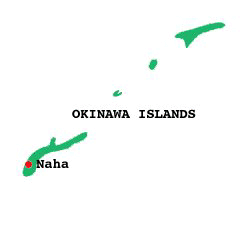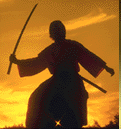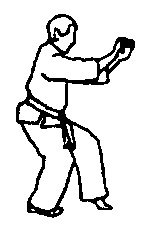Karate: Art of the Empty Hand
A small string of islands linking the main islands of southern Japan to the Chinese offshore island of Taiwan can be accredited as the birthplace of Karate. The Japanese call these islands the Ryukyu Islands. The largest island of the chain is Okinawa, which is also the capital.
The Story of Okinawa
It is thought that the earliest inhabitants of Okinawa came not only from China, but from the northern Japanese islands and from South Asia. Archaeology has shown that cultural penetration of China has continued since at least 300 BC.
In these times, the people of Okinawa lived a simple life supported mainly by a crude agriculture, sea fishing and the gathering of shellfish. However, successive military invasions by the Japanese from the sixth to the ninth centuries AD evidently stimulated the native people to organise themselves into village groupings presided over by chieftains.
 Okinawa had become divided into 3 rival kingdoms by 1340, and a decade later the largest of these kingdoms entered into a formal, tributary relationship with China, which was confirmed by the Chinese Emperor in 1372. Under the terms of this relationship, the Okinawans, like almost all of China's neighbours except for Japan, sent annual delegations to the mainland bearing tribute for the Emperor. A few nobles from these delegations were permitted to travel on from the coast to the Imperial Court. Some younger princes even enrolled in the schools set up for foreigners in Peking, where they would study Chinese culture, arts and sciences before returning home. In this way, many important Okinawans became familiar with the city and court life of China, as well as its traditions and learning.
Okinawa had become divided into 3 rival kingdoms by 1340, and a decade later the largest of these kingdoms entered into a formal, tributary relationship with China, which was confirmed by the Chinese Emperor in 1372. Under the terms of this relationship, the Okinawans, like almost all of China's neighbours except for Japan, sent annual delegations to the mainland bearing tribute for the Emperor. A few nobles from these delegations were permitted to travel on from the coast to the Imperial Court. Some younger princes even enrolled in the schools set up for foreigners in Peking, where they would study Chinese culture, arts and sciences before returning home. In this way, many important Okinawans became familiar with the city and court life of China, as well as its traditions and learning.
By 1429, after some internal skirmishing, Okinawa was united under one king and the first (Sho) dynasty was established. This set the stage for the golden era of Okinawan history. The people took to trading, and steadily established a network of trade links that stretched not only to Japan and China, but as far afield as Indo-China, Thailand, Malaysia, Borneo, Indonesia and the Philippines. Okinawa became a Venice or Genoa of the East, a great centre for the distribution of rare woods, spices, incense, rhinoceros horn, ivory, tin and sugar from the south of Asia. These were exchanged for the fine ceramics, textiles, medicinal herbs and precious metals of Japan, Korea and China.
Okinawan sailors and merchants visited not just China and Japan, but all the great ports of East Asia, a factor that Okinawans of today consider highly important in the history of their martial arts.
The Banning of Weapons
Something else of crucial importance also took place about this time. Around 1470, the collapse of the Sho Dynasty gave rise to a period of political turbulence that was ended only by the establishment of a new (also Sho) dynasty in 1477. The new king, Sho Shin, had to deal with  the rebellious war lords who were firmly entrenched in their castles throughout the island. One of his first moves was to ban the carrying of swords by anyone, noble or peasant. His next move was to order the collection of all weapons, which were to be placed under royal control at his castle in Shuri. Finally, he charged that all nobles, now unarmed, should come and live next to him in the royal capital.
the rebellious war lords who were firmly entrenched in their castles throughout the island. One of his first moves was to ban the carrying of swords by anyone, noble or peasant. His next move was to order the collection of all weapons, which were to be placed under royal control at his castle in Shuri. Finally, he charged that all nobles, now unarmed, should come and live next to him in the royal capital.
It is interesting to note that this policy of first disarming, then 'de-casting', rebellious lords in Okinawa predates the same actions on mainland Japan. These were carried out in the sword edicts of Toyotomi in 1586 and in the Tokugawa Shogun's orders for the daimios or warlords to assemble in his capital in 1634.
It is typical of the convoluted nature of relations between China and Japan that the Shogun did not, however, force the Okinawans to give up their tributary relationship with the Chinese. On the contrary, he forced the Okinawans to maintain a facade of loyalty to the Chinese. Whenever diplomats came from the mainland, the Japanese rulers hid themselves and anything that would betray their presence. Indirect contacts with China, which the Japanese both wanted and needed, were maintained through Okinawa, but the Okinawans' economic wealth and political independence were really annexed to Japan in 1609.
Of vital importance to the following discussion was the fact that after 1609 the Japanese maintained the ban on the carrying of weapons and kept the nobility bottled up in Shuri city. Japanese samurai were, however, allowed to carry their weapons there. The ban on the natives' carrying of weapons evidently remained in force throughout Okinawa's subsequent history; Napoleon, in 1816, on hearing of a small nation state called Okinawa where people carried no weapons remarked: "I cannot understand a people not interested in war".
In Okinawa today, most Karate masters believe that the banning of weapons by one of their first kings was an act of sublime wisdom, not one of oppression.
The Art of the Hand
This brief historical sketch sets the scene for a discussion of the great Okinawan tradition of te, the martial art of the hand, in which the human body is trained to become all the weapons a man or woman may need for self-defence. 
Karate, or Karate-do (the art itself) as we know it today, is largely the product of a synthesis that took place in the eighteenth century between the native Okinawan art of te and the Chinese arts of Shaolin Temple boxing, and other southern styles that were practised at that time in Fukien Province. In the last 70 years, Japanese martial arts have influenced Karate as is practised there, although little of this influence has filtered back to Okinawa.
Te is thought to be at least 1000 years old. The Okinawans of 1000 years ago were not rich, and weapons were in short supply. The land was not unified, and a knowledge of self-defence must have been an important asset and would have provided the necessary impetus to the emergence of an indigenous martial art. Later, in the fifteenth and sixteenth centuries when the Okinawans began to travel extensively, they were sure to have encountered many of the great fighting systems of South Asia and these would have influenced their indigenous art. Certain techniques in today's karate seem to have originated from that part of the world. Okinawa's own style however is unique, and foreign influences have always been modified to conform with the Okinawan fighting principles. Chief among them is the use of the hand (te), and especially the closed fist.
The Divergence of the Okinawan Arts
 When the king, Sho Shin, disarmed the nobles and gathered them into Shuri city, is believed that 2 movements were born in Okinawa. On the one hand, the nobles sought out, learned and developed the unarmed combat art of te. On the other hand, farmers and fishermen began to develop weapons systems based on the combative use of tools and agricultural implements. Flails (hand threshing tools), grindstone handles, sickles, horse bridles and even boat paddles became lethal weapons.
When the king, Sho Shin, disarmed the nobles and gathered them into Shuri city, is believed that 2 movements were born in Okinawa. On the one hand, the nobles sought out, learned and developed the unarmed combat art of te. On the other hand, farmers and fishermen began to develop weapons systems based on the combative use of tools and agricultural implements. Flails (hand threshing tools), grindstone handles, sickles, horse bridles and even boat paddles became lethal weapons.
Both the unarmed and armed traditions were practices in utmost secrecy, and largely confined to their respective social classes. Te was practised by the nobles of the Royal court and Ryukyu bujutsu (Ryukyu weapon arts) grew up among the people. Even in the twentieth century, several of the greatest karate masters, notably Chotoku Kyan, were and are descendants of the royal and noble families of the city of Shuri.
The first recorded performance of Chinese martial arts in Okinawa took place in 1761. There are also several personal histories of the masters of te at that time. Some of these masters, including Chatan Yara, are known to have travelled to Fukien Province in China and studied there. One great Chinese master, Kusanku, spent 6 years in Okinawa. During the nineteenth century the Okinawan art began to be known by the name of T'ang-te or 'Chinese hand'.
Even though the art was practised in great secrecy, in remote places, and largely at night or before dawn, 3 separate styles began to emerge from the 3 urban centres around the capital. Shuri-te, the art that developed in Shuri, was practised by the Samurai of the court, while in the nearby port town of Naha, and in Tomari, the gate-town of Shuri, the people developed their own independent styles of te.
The differences between them probably arise from their having been influenced by different Chinese traditions. There is some evidence to suggest that Shuri-te derives from Shaolin Temple boxing, while Naha-te incorporates more of the soft, Taoist techniques, involving breathing and the control of Ki, the life force, called chi in Chinese. Tomari-te evidently drew from both traditions.
It is important to note, however, that the towns of Shuri, Naha and Tomari are only a few miles apart, and that the differences between their arts were essentially ones of emphasis and not of kind. Beneath these surface differences, both the methods and aims of all Okinawan karate are one and the same.
By the end of the nineteenth century, the names of the styles had changed again. The arts of Shuri and Tomari were subsumed under one name, shorin-ryu, meaning the 'flexible pine school'. Naha-te became known as goju-ryu, the 'hard and soft school', and it was developed by the great master Higaonna Kanryo. Shorin-ryu is subdivided into several slightly different styles, but goju-ryu has remained largely unified stylistically. There has also grown up a tradition in Okinawa and Japan where both styles are fused together and taught as one. The largest school which does this is the Japanese shito-ryu, headed by Mabuni.
Traditionally, it is said that the shorin-ryu style is lighter and faster than goju-ryu, and that the stances are generally higher. The kata of the 2 styles are slightly different: in goju-ryu the arm and leg motions are more bent and circular, and greater emphasis is laid on breathing.
In 1935, a multi-style committee of masters sat down together to decide on a single name for their art. They called it karate, which means 'empty-handed' or 'weaponless' defence art. Some masters feel that the Japanese appendage of -do, 'the way', should also be added to the name. 
Today, karate still flourishes in Okinawa. The destruction of the island's historic buildings, archives and much of its unique heritage during the horrifying battle between the Japanese and the United States' allies in 1945, has led the people to prize even more highly their immaterial cultural assets in the form of dance, music and karate.
Following ancient precedents, karate masters are amongst the most honoured dignitaries of Okinawan society, and dojos or training-halls abound in the built-up areas of Naha and Shuri. Even though there are no overall masters of each style, there is much friendship and little competition between today's leaders of the art.
Reproduced with kind permission of Steven Webster from Edinburgh University Shukokai Karate Club
Back
 Okinawa had become divided into 3 rival kingdoms by 1340, and a decade later the largest of these kingdoms entered into a formal, tributary relationship with China, which was confirmed by the Chinese Emperor in 1372. Under the terms of this relationship, the Okinawans, like almost all of China's neighbours except for Japan, sent annual delegations to the mainland bearing tribute for the Emperor. A few nobles from these delegations were permitted to travel on from the coast to the Imperial Court. Some younger princes even enrolled in the schools set up for foreigners in Peking, where they would study Chinese culture, arts and sciences before returning home. In this way, many important Okinawans became familiar with the city and court life of China, as well as its traditions and learning.
Okinawa had become divided into 3 rival kingdoms by 1340, and a decade later the largest of these kingdoms entered into a formal, tributary relationship with China, which was confirmed by the Chinese Emperor in 1372. Under the terms of this relationship, the Okinawans, like almost all of China's neighbours except for Japan, sent annual delegations to the mainland bearing tribute for the Emperor. A few nobles from these delegations were permitted to travel on from the coast to the Imperial Court. Some younger princes even enrolled in the schools set up for foreigners in Peking, where they would study Chinese culture, arts and sciences before returning home. In this way, many important Okinawans became familiar with the city and court life of China, as well as its traditions and learning.  the rebellious war lords who were firmly entrenched in their castles throughout the island. One of his first moves was to ban the carrying of swords by anyone, noble or peasant. His next move was to order the collection of all weapons, which were to be placed under royal control at his castle in Shuri. Finally, he charged that all nobles, now unarmed, should come and live next to him in the royal capital.
the rebellious war lords who were firmly entrenched in their castles throughout the island. One of his first moves was to ban the carrying of swords by anyone, noble or peasant. His next move was to order the collection of all weapons, which were to be placed under royal control at his castle in Shuri. Finally, he charged that all nobles, now unarmed, should come and live next to him in the royal capital. 
